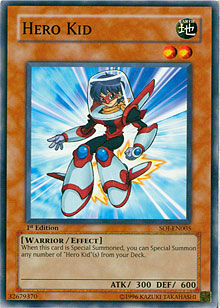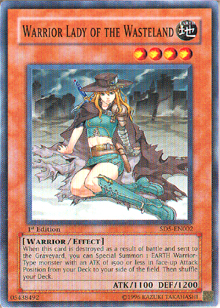Sadly, I don’t have much in the way of witty or roundabout introductions this week. You’ve known this deck was coming since back before Tournament Pack 8 week started, but I had to keep pushing it back due to all the cool stuff to preview in Enemy of Justice. Enemy of Justice is here, the Sneak Previews have come and gone, and now it’s finally time to unveil the deck based around one of my most favorite monsters in the game: Gilford the Lightning
Gilford and Sons
Monsters: 20
2 Gilford the Lightning
1 Moisture Creature
3 Warrior Lady of the Wasteland
3 Hero Kid
1 Elemental Hero Wildheart
1 Mystic Swordsman LV2
1 Big Shield Gardna
2 Blade Knight
1 D. D. Assailant
1 D. D. Warrior Lady
1 Sangan
1 Magician of Faith
1 Exiled Force
1 Breaker the Magical Warrior
Spells: 14
1 Graceful Charity
1 Snatch Steal
1 Heavy Storm
1 Mystical Space Typhoon
1 Last Will
1 Scapegoat
1 Pot of Avarice
1 Nobleman of Crossout
1 Premature Burial
2 Reinforcement of the Army
3 Smashing Ground
Traps: 6
3 Sakuretsu Armor
1 Mirror Force
1 Call of the Haunted
1 Torrential Tribute
For those of you unfamiliar with the history of Gilford the Lighting, allow me to sum it up. Gilford was one of Joey’s cards from the original animated series. It debuted near the end of the Battle City storyline during his semifinal duel with Marik. Since Joey was the only remaining competitor in the tournament who did not possess one of the Egyptian God cards, that should have put him at a distinct disadvantage against Marik, but in true underdog style, Joey fought back with his own card that had similar powers to the Egyptian Gods.
Gilford the Lightning is that card, and if you normal summon it by offering three monsters as tributes instead of two, it blows away every monster on the opponent’s side of the field. We finally got Gilford as part of the 2005 Collectible Tins, but up until now, I haven’t seen anybody try to use it. The main problem with playing Gilford is that if you special summon it (or summon it by only tributing two monsters), it’s just a 2800 ATK body with a secret rare foil pattern. As a strategy, putting three monsters on the field at the same time and then giving them up for one big monster makes most players wince. Lucky for Gilford, I’m not most players.
If I’m going to build a deck around summoning and tributing three monsters for one big monster that wipes out most of my opponent’s field, I might as well have my choice of either destroying all monsters or all spells and traps. Thus, I added a copy of Moisture Creature to go with my two Gilfords. The key to making this exchange worthwhile is to make sure that the monsters I give up are much less valuable than the cards I take away from the opponent.
 The question then became, “What three monsters could I give up that are otherwise useless to me and that also don’t destabilize the deck to the point of un-playability?” A quick dive into the Jank Tank™ revealed the answer: Hero Kid! Hero Kid is one of the few monsters in the game that has both search and swarm capabilities built into it, and it’s also an Earth/Warrior monster, making it even easier to fish out of the deck at will. The only real problem with it is the chance of drawing it in your starting hand, but even then, some clever maneuvering can let you pull off its effect anyway.
The question then became, “What three monsters could I give up that are otherwise useless to me and that also don’t destabilize the deck to the point of un-playability?” A quick dive into the Jank Tank™ revealed the answer: Hero Kid! Hero Kid is one of the few monsters in the game that has both search and swarm capabilities built into it, and it’s also an Earth/Warrior monster, making it even easier to fish out of the deck at will. The only real problem with it is the chance of drawing it in your starting hand, but even then, some clever maneuvering can let you pull off its effect anyway.
One of the major challenges of this deck is not drawing into either of your Gilfords or the single Moisture Creature. To make this less of an issue, the basic engine of the deck follows the Warrior Toolbox-type model. This way you’ll have maximum access to nearly all your good monsters through Reinforcement of the Army and Warrior Lady of the Wasteland, along with the ability to win games even if you need to toss your regular plan out the window. If things are going well, springing Gilford or the Creature on your unsuspecting opponent creates a huge swing in tempo—much like that of a Monarch, except on a grander scale.
Now, Forced Back isn’t quite legal for premier events yet, but it’s fair game for your local Hobby League. If you suspect your opponent has Forced Back face down, don’t summon Gilford. Bottomless Trap Hole isn’t so bad because you still take his or her monsters down with you, but you absolutely can’t afford to get hit with Forced Back. In game 1, you won’t have the luxury of knowing whether or not your opponent maindecks the card, so play as if he or she doesn’t. For the other games, though, if you’re fairly sure your opponent knows what he or she’s doing, then you should definitely prepare for the worst. I recommend siding in some Royal Decrees and activating them right before you make your summon.
Another issue you may have with the deck is that it seems to just make one big push, and if that doesn’t work, the deck fails. This isn’t quite the case. Hero Kids and Gilfords and Wasteland Ladies can be reused thanks to Pot of Avarice, and you can never underestimate the pure power behind the Warrior strategy. If you really think about it, this is the same strategy employed by Monarch Control decks, only with a great deal more showmanship. Where Monarch Control plays Gravekeeper’s Spy and Spirit Reaper, I run Warrior Lady of the Wasteland and Hero Kid. Where it runs Mobius the Frost Monarch and Zaborg the Thunder Monarch, I’ve got Gilford the Lightning and Moisture Creature. This type of similarity is also seen in the various decks built around Return from the Different Dimension. Each one uses different cards to achieve the same goal.
There aren’t any real rulings issues that come up with this deck, so let’s take a look at how you’ll want to play it. The best opening play is to set Sakuretsu Armor and Big Shield Gardna, which sets you up to cause as much trouble to your opponent as humanly possible (he or she will have to commit serious resources to the board in order to get through your setup). Nobleman of Crossout is useless against the Gardna, and your opponent will have to summon Cyber Dragon and another monster in attack position and use some sort of removal on either the monster or your trap in order to cause any damage to your life points on his or her turn.
 Assuming the opponent doesn’t break through your defenses, you’ll then want to summon Warrior Lady of the Wasteland in attack position. If your opponent opted to play defensively on the first turn, go ahead and attack. You want to get your opponent to commit as many cards to the board as possible, so that when he or she inevitably has to attack your Ladies, you’ll be able to fetch out the Hero Kids and tribute them all for Gilford. If the sheer shock of Gilford wiping the field doesn’t cause your opponent to scoop, the huge amount of damage you’ll deal out probably will. After that, just play it like you would any other Warrior-based deck until you (hopefully) win. One Gilford will usually put your opponent so far down that if you just keep pushing, you’ll eventually overwhelm him or her, regardless of how many cards he or she is holding.
Assuming the opponent doesn’t break through your defenses, you’ll then want to summon Warrior Lady of the Wasteland in attack position. If your opponent opted to play defensively on the first turn, go ahead and attack. You want to get your opponent to commit as many cards to the board as possible, so that when he or she inevitably has to attack your Ladies, you’ll be able to fetch out the Hero Kids and tribute them all for Gilford. If the sheer shock of Gilford wiping the field doesn’t cause your opponent to scoop, the huge amount of damage you’ll deal out probably will. After that, just play it like you would any other Warrior-based deck until you (hopefully) win. One Gilford will usually put your opponent so far down that if you just keep pushing, you’ll eventually overwhelm him or her, regardless of how many cards he or she is holding.
Finally, I’ll leave you with some stories about the creation of this deck. I started on it about a month ago right after we switched over to the new Forbidden and Limited lists. The original intent was to combine both the field-clearing elements of Gilford the Lightning with the solid win condition of Return from the Different Dimension. Initially, I had two copies of Divine Sword - Phoenix Blade to remove Hero Kids and other Warrior monsters from play in order to set up my Return and have a card in hand to discard to various spells and traps. Specifically, I was playing cards like Cursed Seal of the Forbidden Spell, Raigeki Break, Lightning Vortex, and Double Spell. (Double Spell, by the way, is absolutely amazing if you can consistently use its effect without having to throw away one of your good spells. It’s perfect for decks using the Phoenix Blade.)
Eventually, I found that trying to mix the two themes together put too much of a strain on the deck, and it became overly draw-reliant. So I decided to drop one of the themes and simply concentrate on the other. Return from the Different Dimension is an excellent and very powerful card in the tournament scene, but this deck wasn’t really supposed to be played in any major tournaments. Since I just wanted something fun to play at my local Hobby League, I decided to go with Gilford the Lightning. For the record, I only lost one match that day.
Next time you’re looking through someone’s trade binder and you see a Gilford, consider picking it up. It’s a fun and effective alternative to running down everyone in Hobby League with the dream-devastating dumptruck of doom that is Chaos Sorcerer and the latest set of Shonen Jump Top 8 decks. And if you’re playing copies of Shonen Jump-winning decks in your Hobby League, it had better be because there aren’t any standard tournaments for you to play and practice in.
Until next time, play hard, play fair, and most importantly, have fun!
Jerome McHale
jcmchale@andrew.cmu.edu
NEXT WEEK: Is there such a thing as destiny? Well, if by destiny, you mean a seven-letter word that appears in the title of some powerful new cards from Enemy of Justice, then I guess the answer is yes.